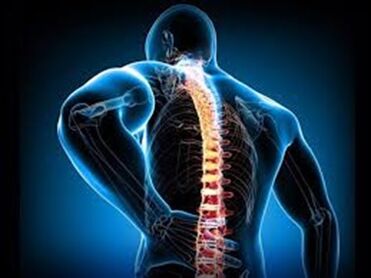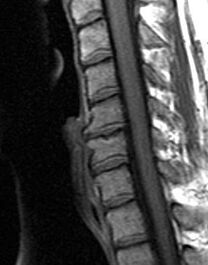Compared with other spine, thoracic degenerative disc disease (osteochondrosis) is a relatively rare disease. This is because the thoracic cavity stabilizes the thoracic spine, limiting movement and injury caused by continuous bending and stretching, as happens with the rest of the spine. If osteochondrosis occurs in the thoracic spine, its occurrence is usually related to trauma.

Depending on the severity of the problem, degeneration, destruction and inflammation of the intervertebral disc area can cause a range of symptoms. Disc disease can cause symptoms such as reduced range of back motion, back pain that may radiate to the intercostal space, numbness, tingling, muscle cramps, or some combination of these symptoms. The most common manifestation of thoracic osteochondrosis occurs at the T8-T12 level. Usually, the manifestations of osteochondrosis in the thoracic spine are: herniation, herniated disc, herniated disc with isolation, and spondylolisthesis.
The treatment of thoracic osteochondrosis is usually conservative, but if there are complications such as spinal cord compression, it can be treated surgically.
Osteochondrosis (degenerative disc disease) is not actually a disease, but a term used to describe the progressive changes of the intervertebral disc associated with progressive wear and the development of symptoms secondary to the degeneration of the intervertebral disc. Disc degeneration is a normal degenerative process, but in some cases, the degenerative process may be accelerated, for example, due to trauma, overuse, and musculoskeletal imbalance (such as scoliosis). Disc degeneration is not a problem in itself, but the conditions associated with it can lead to the development of late symptoms.
Disc degeneration stage
The progress of intervertebral disc degeneration can be divided into the following stages:
disfunction
- There may be tears in the annulus area and irritation of the small joints at the corresponding level of the spine.
- Loss of joint mobility, localized back pain, muscle cramps, and limited trunk mobility, especially limited extension.
Unstable
- The intervertebral disc loses fluid due to dehydration and a drop in the height of the intervertebral disc. Weakness of the small joints and joint capsules may occur, leading to instability.
- Patients will experience shooting pain, spine straightening, and a sharp reduction in the range of trunk motion.
Re-stabilize
- The human body responds to instability by forming additional bone formation in the form of osteophytes, which helps stabilize the spine to a certain extent. However, excessive bone formation can cause spinal stenosis.
- Back pain is usually lessened, but not as severe. Some people may experience symptoms similar to stenosis.
the reason
- Degeneration of the body is the most common cause of degeneration of the intervertebral disc. As the body ages, the intervertebral discs gradually lose their fluid portion and become dehydrated. The intervertebral discs begin to narrow and lose height, impairing their ability to absorb shock and pressure.
- The outer annular fibrous structure of the intervertebral disc will begin to rupture and rupture, thereby weakening the disc wall.
- People who smoke, are obese, and engage in strenuous activities are more likely to develop intervertebral disc degeneration.
- Damage to the spine or intervertebral discs caused by a fall or impact can trigger the degenerative process.
- A herniated disc can trigger the development of disc degeneration.
- Unlike muscles, intervertebral discs have very little blood supply, so they have no repair capabilities.
symptom
The symptoms associated with thoracic osteochondrosis will depend on the location and structure involved in the process. Degeneration of thoracic discs can affect the back, the area under the shoulder blades, or along the ribs.
- Many patients with thoracic degenerative disc disease may have no symptoms.
- Chronic chest pain with/without radiation to the ribs.
- In the case of nerve compression, sensory changes such as numbness, tingling, or paresthesias occur.
- Muscle cramps and postural changes in the chest and back.
- Loss of range of motion reduces the ability to move the torso, especially when rotating or bending to one side.
- Sitting for a long time can cause back pain and arm pain.
- It is difficult to lift heavy objects and raise arms above the head.
- In the later stages, spinal stenosis may occur, leading to weakness of the lower limbs and loss of motor coordination. In these cases, surgery will be required.
diagnosis

In addition to a thorough examination, the doctor may request the following tests to verify the diagnosis:
- X-ray,Helps determine if there is joint degeneration, fractures, bone deformities, arthritis, tumors or infections.
- NMRDetermine the morphological changes of soft tissues, including visualization of intervertebral discs, spinal cord, and nerve roots.
- CT scanCan provide a scan of the cross-sectional image of the spine structure.
- EMG,This diagnostic method is used to determine nerve damage and the degree of damage.
- MyelographyUsually, this research method is necessary to clarify the degree of morphological changes affecting the root and spinal cord and plan surgical interventions.
treatment
The treatment of thoracic osteochondrosis depends on the severity of the condition.
Treatment of acute pain syndrome:
- Rest: Avoid activities that cause pain (bending, lifting, twisting, twisting, or stretching backwards).
- Medications to reduce inflammation (anti-inflammatory drugs and painkillers).
- In acute cases, ice can relieve cramps and relieve pain.
- Local heating can help relieve pain and muscle tension.
- Light gymnastics exercises to eliminate the biomechanical obstacles associated with osteochondrosis, and to improve the range of motion of the joints, the normal shape, posture and range of motion of the spine.
- It may be necessary to use a brace to relieve pressure on the small joints and thoracic spine muscles.
- Corticosteroids are used to reduce inflammation in moderate to severe cases.
- The epidural injection directly enters the damaged disc area.
In mild cases, the use of local colds and medications may be sufficient to relieve the pain. After the pain is relieved, exercise therapy (physical therapy) and exercises to stretch and strengthen the back muscles are recommended. Normal activities should be resumed gradually to prevent recurrence of symptoms.
The main conservative method for the treatment of thoracic osteochondrosis
medical treatement
The use of drugs to treat thoracic osteochondrosis, especially acute pain syndrome, is to reduce pain, inflammation and muscle spasms.
- Over-the-counter medicine for mild to moderate pain.
- A narcotic analgesic used for severe pain that cannot be controlled by other treatments.
- Muscle relaxants can reduce acute muscle spasms.
- Prescription analgesics.
- Injections, such as small joint injections, occlusion, or epidural injections. These may include injecting corticosteroids into specific areas to reduce local inflammation.
- Manual therapy, including soft tissue massages, joint extensions and activities performed by experts, can improve the geometry, range of motion and range of motion of the thoracic spine. Using mobilization techniques can also help regulate pain.
- Exercise therapy (therapeutic exercises), including stretching and muscle strengthening exercises to restore the range of motion and strengthen the muscles of the back and abdomen, support, stabilize and reduce pressure on the intervertebral discs and back. The exercise program should be started after the pain, muscle cramps, and inflammation subsided, especially weight-bearing or weight-bearing exercises. An improper exercise plan can aggravate symptoms. Therefore, the choice of exercise must be carried out with the exercise therapist.
- Neuromuscular retraining to improve posture, restore stability, and teach patients the correct exercise biomechanics to protect damaged discs and spine.
- Physical therapy, including the use of ultrasound, electrical stimulation, and cold lasers, can help reduce pain and inflammation of the spinal structure.
- Home exercise programs, including muscle strengthening, stretching and stabilization exercises, and lifestyle changes to reduce spinal pressure.
- acupuncture. This method of treatment can be used in the presence of sensory disturbances or restoration of conduction and relief of pain.
Surgical treatment
Most hernias in the thoracic spine located in the thoracic intervertebral disc can be successfully treated without surgery. However, when conservative treatment of thoracic osteochondrosis is ineffective, surgery may be recommended, especially if the patient has some of the following symptoms:
- Radical pain aggravated.
- Increase pain and nerve damage.
- The development or increase of muscle weakness.
- Increased numbness or paresthesia.
- Loss of control of bowel and bladder function.
The most common surgery associated with disc degeneration is a discectomy, in which the disc is removed through an incision. However, in the case of osteochondrosis and intervertebral disc degeneration, several surgical procedures can be recommended. The choice of surgical method depends on the cause of the symptoms. Basic surgical techniques-including foraminotomy, laminectomy, laminectomy, spinal decompression and spinal fusion.
forecast
Most of the problems associated with thoracic osteochondrosis can be resolved without surgery, and people can return to normal work. Due to the stiffness of the anatomical structure, the occurrence of thoracic spine osteochondrosis is less than other parts. The duration of treatment usually does not exceed 4-12 weeks, depending on the severity of symptoms. The patient needs to continue the stretching, strengthening, and stabilizing exercise program. A good long-term prognosis requires the use of appropriate exercise and body mechanics, and awareness of the importance of maintaining a healthy spine.































